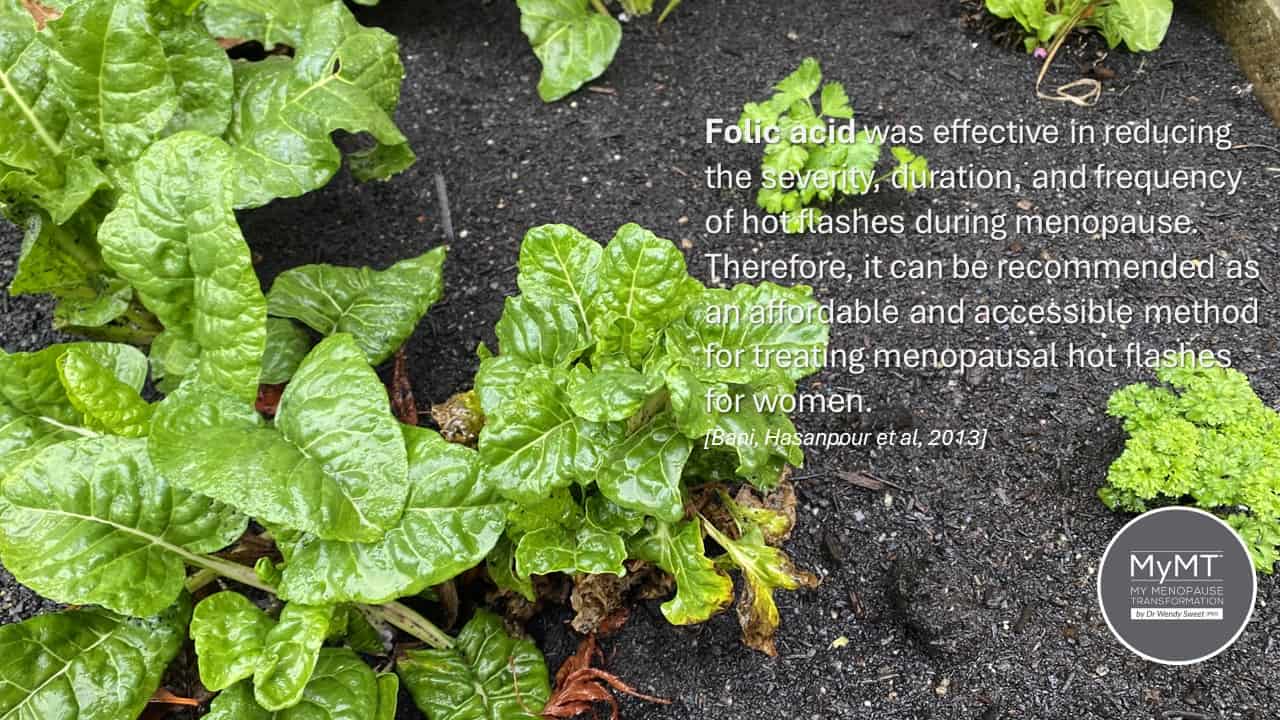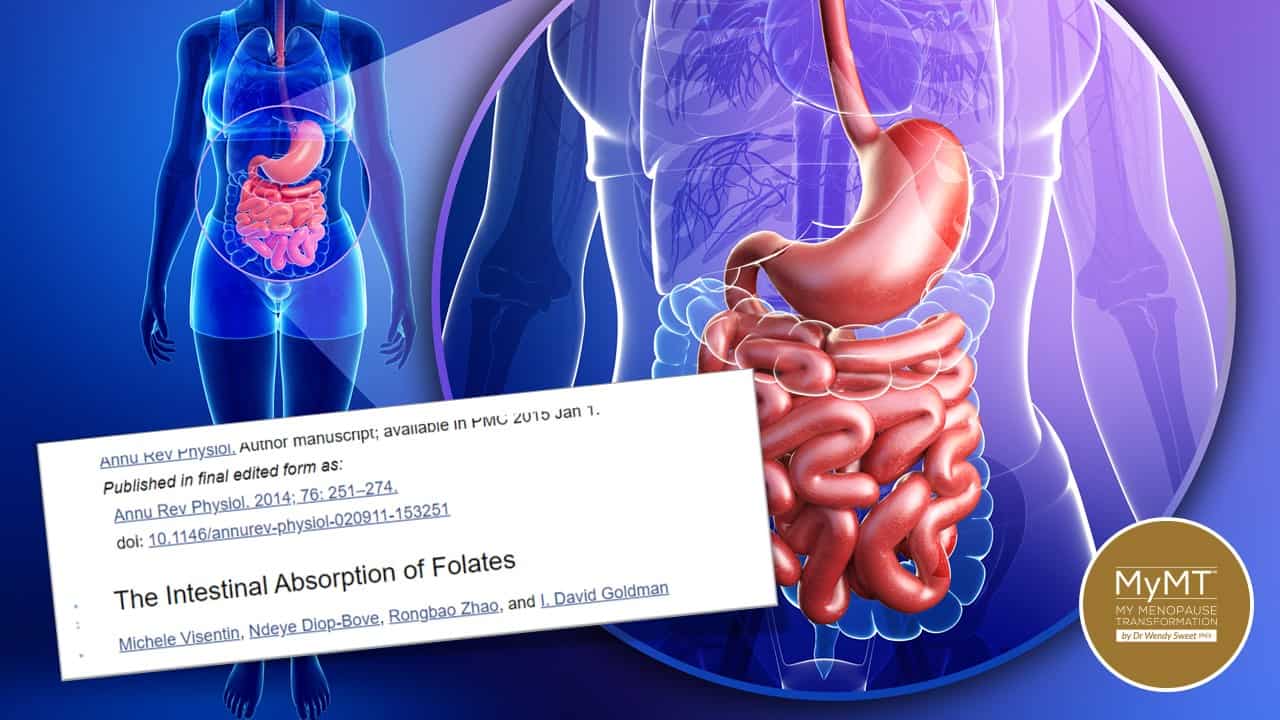The Connection Between Your Hot Flushes and Folate in Menopause.
The photo below is my garden right now. The spinach and parsley are taking off with the spring rain and I’m looking forward to enjoying the new season’s growth on my dinner plate.
How I wish that I had planted both spinach and parsley a few years ago when I was in peri-menopause. Instead I was paying a lot of money to various supplement companies and taking HRT to try and alleviate my hot flushes and night sweats.
It’s no surprise that they weren’t working very well. Simply because I wasn’t changing my nutrition and I didn’t know ‘what’ to change. At the time, I didn’t understand the powerful connection between folate and some of our menopause symptoms.
Looking at the ingredients lists of the supplements I used to take, I can now see that many of them have folic acid added to them. This is the synthetic form of folate, which is naturally present in greens.
Spinach, Kale and Parsley are high in a nutrient called Folate. The synthetic form of this is known as Folic Acid.
It’s added to numerous menopause supplements.
Whilst I knew about the importance of folate in pregnancy, I had no idea that I needed this vitamin to help alleviate my hot flushes and night sweats.
“Folic acid was effective in reducing the severity, duration, and frequency of hot flashes during menopause. Therefore, it can be recommended as an affordable and accessible method for treating menopausal hot flashes for women.” [Bani, Hasanpour et al, 2013].
Folate is Vitamin B9. When absorbed into its active form it is converted to tetrahydrofolate. No, you don’t have to pronounce this, because it is known simply as Folate.
Folate is a nutrient that you may have heard of. It is an essential cofactor (helper) for the production of both nor-adrenaline/nor-epinephrine (a nerve transmitter that is related to your stress hormones) and serotonin.
As many of you on menopause-related anti-depressants already know, serotonin production in our brain is reduced as our oestrogen production declines during menopause. But did you know that studies have shown that taking folic acid has effects similar to that of antidepressants too? (Young, 2007).

There is so much pressure on us to buy supplements for our menopause symptoms, especially in many Western countries whereby, the supplement industry is booming. The phenomenal growth in menopause supplements has happened over our lifetime and yes many of them are helpful to us. However, if you look at the ingredients, they often promote B-vitamins, including Folate. Don’t get me wrong – many are extremely useful, but so too is understanding the nutrients that our body needs at this age and stage of life.
I was taking a lot of supplements myself. What I didn’t realise was that I also needed to change my nutrition to better suit menopause hormonal changes. Sorting out my changing liver and gut health was important too. Poor liver and gut health affects the absorption of nutrients that help to alleviate our symptoms.
For example, the total body content of folate is estimated to be 10 to 30 mg; about half of this amount is stored in the liver and the remainder in blood and body tissues. If your liver isn’t healthy, or your alcohol intake is high, please take note – alcohol interferes with folate absorption and metabolism and accelerates its breakdown, rather than its absorption. [National Institutes of Health Factsheet]
For those of you who are smokers, then this is even more important to understand, as smoking is known to reduce the absorption of folate. [Ganguly & Alam, 2015].
Folate absorption is important and it’s why one of the optional modules I have for you in my programmes, is about restoring your gut health … with the information in this module, you will understand the evidence behind helping your gut and liver absorb not only folate, but other B-vitamins too.
Folates are absorbed primarily in the duodenum and jejunum within the acid micro-environment at the cell surface on the gut wall, so if you have IBS, Coeliac Disease or other gut health concerns, then this is something to remember.

With the folate that we do absorb, this helps mid-life and older women to keep our homocysteine levels in check. And doing this is good for your ageing heart and your hot flushes.
Over 30 years ago, studies out of Harvard University suggested that a vitamin deficiency of folate could be a major cause of heart disease in older women. At the time, nobody listened. But now, scientists know of the link between folate, homocysteine and heart disease.
Homocysteine is an amino acid (protein) and is a natural compound that needs to be kept in check. If levels in our body become too high, then we can develop allergies and/or develop heart disease and/or our hot flushes and night sweats may increase and stay around in post-menopause too. The body uses folate and other B-vitamins to keep homocycsteine levels in check.
EAT YOUR GREENS
What’s the connection with greens?
Spinach, steamed or slightly boiled or wilted to break down the fibres, is probably your best bet for managing homocysteine and helping to reduce your hot flushes. Around 1/2 a cup of spinach delivers 130 micrograms of folate and with the recommended daily intake being around 400 micrograms per day, greens such as spinach pack a powerful punch. So too does parsley.
If women have osteopenia or osteoporosis however, then loading up with spinach may not be quite so well tolerated. Spinach is also known to reduce the absorption of calcium as it is high in oxylates (oxalic acid). Because oxalates bind to calcium as they leave the body, they can increase the risk of kidney stones in some people, or contain some risk for women with osteoporosis.
Don’t forget too, that Folate intake is strongly influenced by various methods of cooking that can degrade the natural forms of the vitamin in foods. A fabulous nutrition study out of the United Kingdom suggests that steaming (less than 4 minutes) is best, so you don’t lose the folate benefits of the spinach. (McKillop, Pentieva et al., 2002).
Folate is also found naturally in a wide variety of other foods, including vegetables (especially dark green leafy vegetables), fruits, nuts, beans, peas, dairy products, poultry and meat, eggs, seafood, and grains.
Spinach, liver, yeast, asparagus, and Brussels sprouts are among the foods with the highest levels of folate and these are all included in the MyMT™ Food Guide which is part of the 12 week online programmes I’ve designed for women at this important life-stage.
Whilst folate is added to many processed products, knowing how to reduce our reliance on processed foods is an important emphasis that I make on the programmes. I know it’s often difficult to change our nutrition when we are cooking for others, so that’s why I have a lot of evidenced behaviour-change strategies in the programmes for you as well.
Dr Wendy Sweet (PhD)/ MyMT™ Founder/ Member: Australasian Society of Lifestyle Medicine.

References:
Arikawa AY, Kurzer MS. Associations between Diet Quality and Anthropometric Measures in White Postmenopausal Women. Nutrients. 2021 Jun 6;13(6):1947.
Bani, S., Hasanpour, S., Farzad Rik, L., Hasankhani, H., & Sharami, S. H. (2013). The effect of folic Acid on menopausal hot flashes: a randomized clinical trial. Journal of Caring Sciences, 2(2), 131–140.
Folate Fact Sheet for Health Professionals. https://ods.od.nih.gov/factsheets/Folate-HealthProfessional/
Ganguly, P., & Alam, S. F. (2015). Role of homocysteine in the development of cardiovascular disease. Nutrition journal, 14, 6. https://doi.org/10.1186/1475-2891-14-6
McKillop DJ, Pentieva K, Daly D, McPartlin JM, Hughes J, Strain JJ, Scott JM, McNulty H. (2002). The effect of different cooking methods on folate retention in various foods that are amongst the major contributors to folate intake in the UK diet. Br J Nutr. 88(6):681-8. doi: 10.1079/BJN2002733. PMID: 12493090.
Milart, P., Woźniakowska, E., & Wrona, W. (2018). Selected vitamins and quality of life in menopausal women. Menopause review, 17(4), 175–179. https://doi.org/10.5114/pm.2018.81742
Tjiattas L, Ortiz DO, Dhivant S, Mitton K, Rogers E, Shea TB. (2004). Folate deficiency and homocysteine induce toxicity in cultured dorsal root ganglion neurons via cytosolic calcium accumulation. Aging Cell. 3(2):71-6. doi: 10.1111/j.1474-9728.2004.00086.x. PMID: 15038821.
Visentin, M., Diop-Bove, N., Zhao, R., & Goldman, I. D. (2014). The intestinal absorption of folates. Annual review of physiology, 76, 251–274. https://doi.org/10.1146/annurev-physiol-020911-153251
Young S. N. (2007). Folate and depression–a neglected problem. Journal of psychiatry & neuroscience : JPN, 32(2), 80–82.


